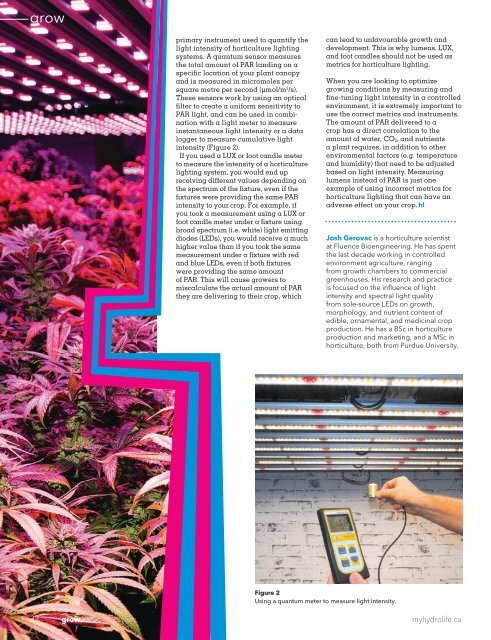Hydrolife Magazine April/May 2017 (Canada Edition)
To know where you’re going, you have to know where you’ve been. The adage rings true for the modern cannabis industry, which is why this issue of Hydrolife takes a look back at the roots of marijuana and how the plant has traveled through history in North America (History of Cannabis Part II).
To know where you’re going, you have to know where you’ve been. The adage rings true for the modern cannabis industry, which is why this issue of Hydrolife takes a look back at the roots of marijuana and how the plant has traveled through history in North America (History of Cannabis Part II).
You also want an ePaper? Increase the reach of your titles
YUMPU automatically turns print PDFs into web optimized ePapers that Google loves.
grow<br />
primary instrument used to quantify the<br />
light intensity of horticulture lighting<br />
systems. A quantum sensor measures<br />
the total amount of PAR landing on a<br />
specific location of your plant canopy<br />
and is measured in micromoles per<br />
square metre per second (µmol/m 2 /s).<br />
These sensors work by using an optical<br />
filter to create a uniform sensitivity to<br />
PAR light, and can be used in combination<br />
with a light meter to measure<br />
instantaneous light intensity or a data<br />
logger to measure cumulative light<br />
intensity (Figure 2).<br />
If you used a LUX or foot candle meter<br />
to measure the intensity of a horticulture<br />
lighting system, you would end up<br />
receiving different values depending on<br />
the spectrum of the fixture, even if the<br />
fixtures were providing the same PAR<br />
intensity to your crop. For example, if<br />
you took a measurement using a LUX or<br />
foot candle meter under a fixture using<br />
broad spectrum (i.e. white) light emitting<br />
diodes (LEDs), you would receive a much<br />
higher value than if you took the same<br />
measurement under a fixture with red<br />
and blue LEDs, even if both fixtures<br />
were providing the same amount<br />
of PAR. This will cause growers to<br />
miscalculate the actual amount of PAR<br />
they are delivering to their crop, which<br />
can lead to unfavourable growth and<br />
development. This is why lumens, LUX,<br />
and foot candles should not be used as<br />
metrics for horticulture lighting.<br />
When you are looking to optimize<br />
growing conditions by measuring and<br />
fine-tuning light intensity in a controlled<br />
environment, it is extremely important to<br />
use the correct metrics and instruments.<br />
The amount of PAR delivered to a<br />
crop has a direct correlation to the<br />
amount of water, CO 2, and nutrients<br />
a plant requires, in addition to other<br />
environmental factors (e.g. temperature<br />
and humidity) that need to be adjusted<br />
based on light intensity. Measuring<br />
lumens instead of PAR is just one<br />
example of using incorrect metrics for<br />
horticulture lighting that can have an<br />
adverse effect on your crop.<br />
Josh Gerovac is a horticulture scientist<br />
at Fluence Bioengineering. He has spent<br />
the last decade working in controlled<br />
environment agriculture, ranging<br />
from growth chambers to commercial<br />
greenhouses. His research and practice<br />
is focused on the influence of light<br />
intensity and spectral light quality<br />
from sole-source LEDs on growth,<br />
morphology, and nutrient content of<br />
edible, ornamental, and medicinal crop<br />
production. He has a BSc in horticulture<br />
production and marketing, and a MSc in<br />
horticulture, both from Purdue University.<br />
Figure 2<br />
Using a quantum meter to measure light intensity.<br />
22 grow. heal. live. enjoy.<br />
myhydrolife.ca




![Hydrolife Magazine December 2017/January 2018 [CANADIAN EDITION]](https://img.yumpu.com/59790088/1/190x247/hydrolife-magazine-december-2017-january-2018-canadian-edition.jpg?quality=85)
![Hydrolife Magazine December 2017/January 2018 [USA EDITION]](https://img.yumpu.com/59790042/1/190x247/hydrolife-magazine-december-2017-january-2018-usa-edition.jpg?quality=85)
![Hydrolife Magazine October/November 2017 [Canada Edition]](https://img.yumpu.com/59493562/1/190x247/hydrolife-magazine-october-november-2017-canada-edition.jpg?quality=85)
![Hydrolife Magazine October/November 2017 [USA Edition]](https://img.yumpu.com/59493548/1/190x247/hydrolife-magazine-october-november-2017-usa-edition.jpg?quality=85)
![Hydrolife Magazine August/September 2017 [USA Edition]](https://img.yumpu.com/59236656/1/190x247/hydrolife-magazine-august-september-2017-usa-edition.jpg?quality=85)








